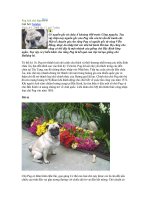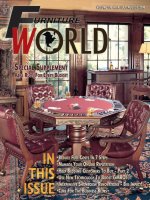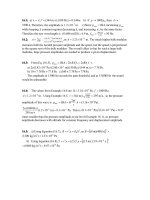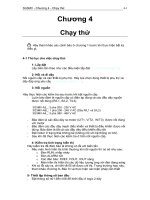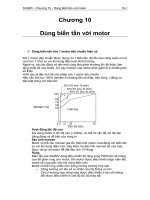Tài liệu FEPC TRUSS ANALYSIS TUTORIAL ppt
Bạn đang xem bản rút gọn của tài liệu. Xem và tải ngay bản đầy đủ của tài liệu tại đây (102.63 KB, 15 trang )
FEPC
TRUSS ANALYSIS TUTORIAL
2-D Truss Bridge
February, 2000
Copyright 2000 C. E. Knight
PURPOSE OF THE TUTORIAL
This tutorial is designed to guide the beginning student in finite element analysis through a simple truss
analysis using the software called FEPC. Step by step instructions are given for defining the model,
inputting the data, executing the analysis and evaluating the results. This provides an introduction to the
software and its command structure along with use and limitations of truss elements.
After completion of the tutorial you should have a basic understanding of the software operation and use of
truss elements in a finite element model. For a more complete description of the software and its
capabilities you may read the user’s guide by opening the file FEPC33.DOC in a simple text editor such as
WORDPAD (It is not a MS WORD file) or open the file FEPC33.WP using WORDPERFECT.
Conventions
To help make the tutorial easier to follow some conventions are defined below. A command or item that
needs to be performed is listed on the left. To the right is the description of the action or result of the
action.
Fepcip Type “fepcip” followed by the enter key to start the FEPC input processor. This must be
entered on a DOS command line and the program file ‘fepcip.exe’ must reside in the
current directory or be located through the existing PATH.
Fepc ‘filename’ Type “fepc” followed by a space and the ‘filename’(no ext.) of the model to be analyzed
followed by the enter key to start the FEPC solver. This must be entered on a DOS
command line and the program file ‘fepc.exe’ must reside in the current directory or be
located through the existing PATH. The file ‘filename’.ana must reside in the current
directory or may have path designation as part of the ‘filename’.
Fepcop Type “fepcop” followed by the enter key to start the FEPC output processor. This must
be entered on a DOS command line and the program file ‘fepcop.exe’ must reside in the
current directory or be located through the existing PATH. You will be prompted for the
‘filename’ of the model for which results will be displayed.
F2 Model Data A typical menu command line in the Input and Output Processors. The command is
executed by pressing the F2 function key or by using a mouse “left click”. These menu
selections lead to another menu level or to a prompt to enter data.
Prompt The software will prompt the user for keyboard input in response to some menu
commands. Following the prompt, key in the data requested followed by the enter key.
Multiple data entries may be separated by a comma or space.
Mouse Use the mouse to make command selections from the menu by a “left click”. The mouse
may also be used for graphic detection in the graphics window using a “left click”. When
multiple detections are allowed, a “right click” terminates graphic detection input.
↵ó Press the ENTER key to terminate keyboard input.
7 Enter all data requested by the prompt from the keyboard.
Steps in the tutorial will be given in tables such as shown below. The first column gives
the function key, the second column gives the command name, and the third column
gives a description of the command or more detailed instructions.
F2 MODEL DATA Select this command to open the submenu for input of model data such as node
point locations, element connectivity, loads, boundary conditions, etc.
Analysis of a 2-D Truss Bridge
In the following tutorial, you will design and analyze a given 2-D truss bridge using the FEPC finite
element personal computer software. The members of the bridge are assumed to behave as trusses. The
tutorial may be outlined in four stages.
I. Input Processing – Create the model using FEPCIP to specify all geometry, boundary supports,
loads, and material and section properties, and store an input file for solution.
II. Solving – Execute FEPC to get a static linear elastic solution.
III. Output Processing – View the deformed shape, member loads and stresses using FEPCOP.
IV. Redesign and Reanalysis – Make changes required for a safe design, and reanalyze the model to
verify the design changes.
Problem Description
A 2-D Truss Bridge is sketched in the figure that has an overall length of 24 ft. and a maximum height of 6
ft. It is to be made of steel members having a yield strength of 36 kpsi. The lower left corner is assumed to
be pinned to the ground while the lower right corner is supported on a roller so that horizontal motion is not
constrained. The worst case design load is when one 20,000 lb. vehicle is centered on the left bottom
member and another vehicle is centered on the central bottom member.
Suitable cross sections for each member are to be chosen for an overall factor of safety of 4.0 of the bridge.
5.75
8 8
24
6
4.50
I. Input Processing
Begin the analysis by starting the FEPC Input Processor. From a DOS command line type:
Fepcip
Followed by the enter key. The program file fepcip.exe must reside in the current DOS directory or its
directory location must be supplied in the current DOS PATH.
The graphic input screen will open with the display shown on the next page.
F2 MODEL DATA Left click or press F2 to open the submenu for input of model data.
F1 ELEM TYPE Click to open the element library menu.
F1 TRUSS Click to select the truss element for this model.
prompt IS TRUSS 2D OR 3D? (Enter 2 OR 3)
7
2 ↵ó
F2 MATL PROP Click to open the submenu.
F1 INPUT Click to key in data for the truss element properties.
prompt ENTER MATERIAL SET #
7
1 ↵ó
There may be more than one material in a model and each element must have a
material set #. When elements are created they are automatically assigned the
current material set #. This first model will have only one material set.
prompt ENTER E, A FOR MATERIAL # 1
7
30E6, 1 ↵ó
The modulus of elasticity of steel and a cross sectional area of 1 in
2
are
entered. These numerical values for the modulus and area have a units system
of inch, pound so the remainder of the model must be consistent. An area of 1
was used so that member loads could be determined and from the loads
calculate suitable cross section areas for the members to meet the design goal.
F10 PREV MENU Click to back up one menu level.
The element has been selected and one set of material and physical properties has been defined. The only
appearance change from the startup screen is that current model data is printed in the upper right in the
model summary box. It should indicate a 2D TRUSS ELEMENT, 0 NODES, 0 ELEMENTS 1 MATL
SET, and the CURRENT MATL IS 1.
This is a good time to introduce file saving. At this point all the model data is in volatile memory of the
computer. In order to save the work that has been done, it must be stored to files. Two files will be stored
if enough data has been entered. They will have extensions of .mod and .ana using your supplied file name.
If there is not a minimum data set to run an analysis, only the .mod file will be written. The .mod file stores
all the input data and is read into FEPCIP when using the recall option. The .ana file is the input file for the
solver, FEPC, so it isn’t needed until the model is complete.
F10 PREV MENU Back up to the main menu.
F1 FILES Left click or press F1 to open the submenu for storing and recalling data files.
F2 STO FN.MOD
& FN.ANA
Click to store the current entered data. If you store and exit FEPCIP use the F1
RECALL function to bring the model data back in when you want to continue
working on the model.
prompt ENTER FILE NAME – NO EXT# (The filename itself may only be 8
characters long due to DOS limitations, but the character string entered may be
up to 20 characters long to include any path designations. The 20 characters
include the drive letter.)
7
Br-truss ↵ó
Enter br-truss or any other file name you choose.
prompt BR-TRUSS.MOD file written
7
Press any key
prompt NO ELEMENTS DEFINED
7
Press any key
prompt Analysis file, br-truss.ANA, not written – incomplete data.
7
Press any key The fn.ana file must be written in order to execute a solution. Be sure it
happens on the last file save before exiting FEPCIP.
F10 PREV MENU Click to back up one menu level.
The next step in building the model is to define nodes. Referring to the bridge drawing there are 7 joints in
the structure, so there will be 7 nodes in the model. Dimensions in the drawing will specify the node
location. As stated before, the numerical values of modulus and area have established an inch, pound unit
system. Since the drawing dimensions are given in feet, they must be converted to inches before data
entry.
F3 NODE DEF Left click or press F3 to open the submenu for input of node data.
F1 DEFINE Click to begin entry of node #’s and coordinates. The node number pattern
chosen for this model starts at the left node and proceeds to the right in
consecutive order.
prompt ENTER NODE #, X, Y, Z =
7
1, 0, 0 ↵ó
Choosing the coordinate system origin at the left node, node #1 has x,y = 0,0
7
2, 69, 54 ↵ó
If a mistake is made, it may be corrected by using the backspace key before
pressing the ENTER key or by defining it again with corrected data.
7
3, 96, 0 ↵ó
7
4, 144, 72 ↵ó
7
5, 192, 0 ↵ó
7
6, 219, 54 ↵ó
7
7, 288, 0 ↵ó
7
↵ó
Press the ENTER key with no input to terminate data entry.
At this point all nodes in the model have been defined, but don’t appear on screen. This is because the
initial window size is 10 x 10 units. Autoscaling will fit all nodes in the window.
F8 VIEW OPTS Left click or press F8 to open the submenu for scaling the view.
F1 AUTOSCALE Click to rescale the view so that the entire model fits in the graphics window.
F10 PREV MENU Click the return to the previous menu.
F9 DSPLY OPTS By default the node numbers are not displayed. You may wish to turn them on.
F2 LABEL SW Click or press F2 to open the submenu for display control of node and element
numbers or labels.
F1 NODE NOS
prompt OK TO SWITCH ON [Y]#
7
↵ó
Press the ENTER key to accept the default Y for yes, or type N for no if the
display should not be changed.
F10 PREV MENU If answer is Y then node numbers will appear on the plot.
Any nodes that appear to be out of position may now be corrected by going back through the F1 DEFINE
and entering the correct data. F6 QUERY may be used to check the exact location of any node. Right
mouse click terminates query node input. The input screen should now look like the following figure.
